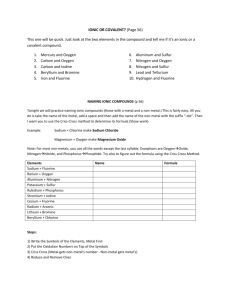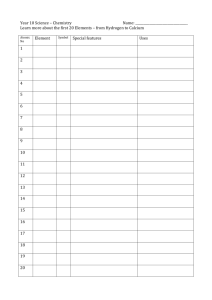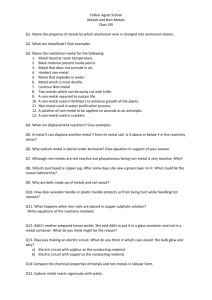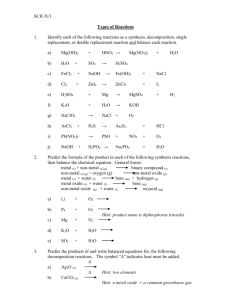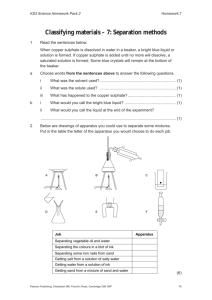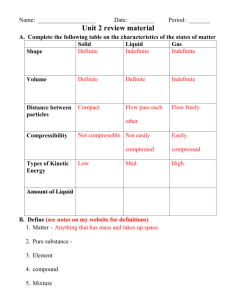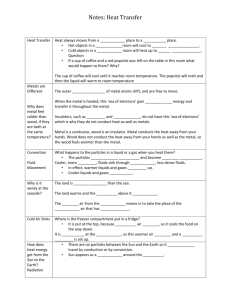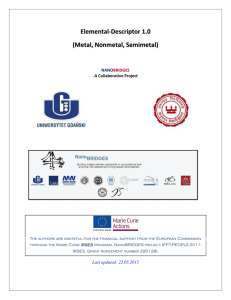KEY
advertisement
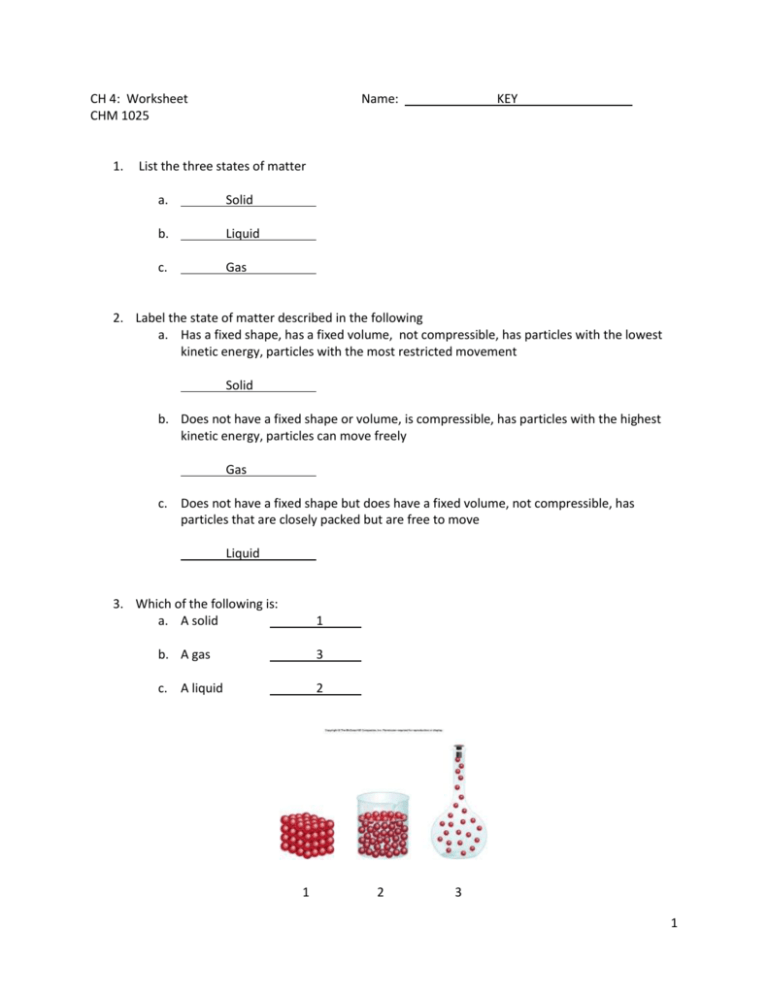
CH 4: Worksheet CHM 1025 1. Name: KEY List the three states of matter a. Solid b. Liquid c. Gas 2. Label the state of matter described in the following a. Has a fixed shape, has a fixed volume, not compressible, has particles with the lowest kinetic energy, particles with the most restricted movement Solid b. Does not have a fixed shape or volume, is compressible, has particles with the highest kinetic energy, particles can move freely Gas c. Does not have a fixed shape but does have a fixed volume, not compressible, has particles that are closely packed but are free to move Liquid 3. Which of the following is: a. A solid 1 b. A gas 3 c. A liquid 2 1 2 3 1 4. Label the type of physical change in the following and tell me if the kinetic energy of the particles is increasing or decreasing Type or a. Solid Gas sublimation b. Solid Liquid melting c. Liquid Solid freezing d. Liquid Gas vaporization e. Gas Solid deposition condensation f. Gas Liquid 5. Write brief definitions for the following: a. Mixture Composed of more than 1 substance and can be physically separated into its component substances b. Heterogeneous mixture properties Matter with indefinite composition and variable c. Homogeneous mixture Matter with definite composition, with constant properties for 1 sample, but variable properties from sample to sample d. Pure substance Matter with definite composition and constant properties (elements & compounds) e. Compound Pure substance that can be broken down into 2 or more simpler substances by a chemical reaction f. Element reaction Pure substance that can’t be broken down by ordinary chemical 2 6. Label the following, heterogeneous mixture, homogeneous mixture, element or compound a. Air Homo b. Copper Element c. Bronze alloy Homo d. Saltwater Homo e. Carbon dioxide Cmpd 7. What is the most abundant element on earth? 8. What is the most abundant element in the human body? oxygen oxygen 9. Write the chemical symbol for the following and label metal, non-metal, or semi-metal and label elemental state in normal conditions Chemical Chemical Metal, non-metal, or semi-metal Solid, liquid, or gas at Name Symbol 25C & 1 atm Hydrogen H Non-metal Gas Silicon Si Semi-metal Solid Mercury Hg Metal Liquid Carbon C Non-metal Solid Terbium Tb Metal Solid Nitrogen N Non-metal Gas Sulfur S Non-metal Solid Oxygen O Non-metal Gas Zinc Zn Metal Solid Chromium Cr Metal Solid Lead Pb Metal Solid Iron Fe Metal Solid Argon Ar Non-metal Gas Manganese Mn Metal Solid Molybdenum Mo Metal Solid Sodium Na Metal Solid Iodine I Non-metal Solid Potassium K Metal Solid Bromine Br Non-metal Liquid Boron B Semi-metal Solid Uranium U Metal Solid 3 10. Write brief definitions for the following: a. Chemical formula An abbreviation for the name of a chemical compound that indicates the # and type of atoms in it b. Molecule A particle composed of 2 or more non-metals c. Law of definite composition constant proportion by mass Compounds always contain the same elements in a 11. State the total number of each type of atom in the following a. C6H12O6 i. C = 6 ii. H =12 iii. O =6 b. CH3NH2 i. C =1 ii. H =5 iii. N =1 c. CH3(CH2)5CH3 i. C =7 ii. H =16 d. Fe(OH)3 i. Fe =1 ii. O =3 iii. H =3 e. C6H5NH2 i. C =6 ii. H =7 iii. N =1 f. Na2SO4 i. Na =2 ii. S =1 iii. O =4 4 12. Write brief definitions for the following: a. Physical property Characteristic of a pure substance that we can observe without changing it’s composition b. Chemical property Describes the chemical reactions of a pure substance c. Physical change A change where the chemical composition is not changed d. Chemical change A chemical reaction 13. Label the following physical or chemical properties a. Boiling point Physical b. Reacts with oxygen Chemical c. Density Physical d. Unreactive in acid Chemical e. Color Physical 14. Label the following physical or chemical changes a. Dissolving Physical b. Rusting Chemical c. Burning Chemical d. Freezing Physical 5 15. Write brief definitions for the following: a. Energy Ability to do work b. Potential energy Stored energy based on position or composition c. Kinetic energy Energy of motion 16. Name the six forms of energy a. Heat b. Light c. Chemical d. Electrical e. Mechanical f. Nuclear 6
![[RH] Chemistry - Hodder Education](http://s3.studylib.net/store/data/009655449_1-244c3ac98c70ac57156679dff49dd5a0-300x300.png)
